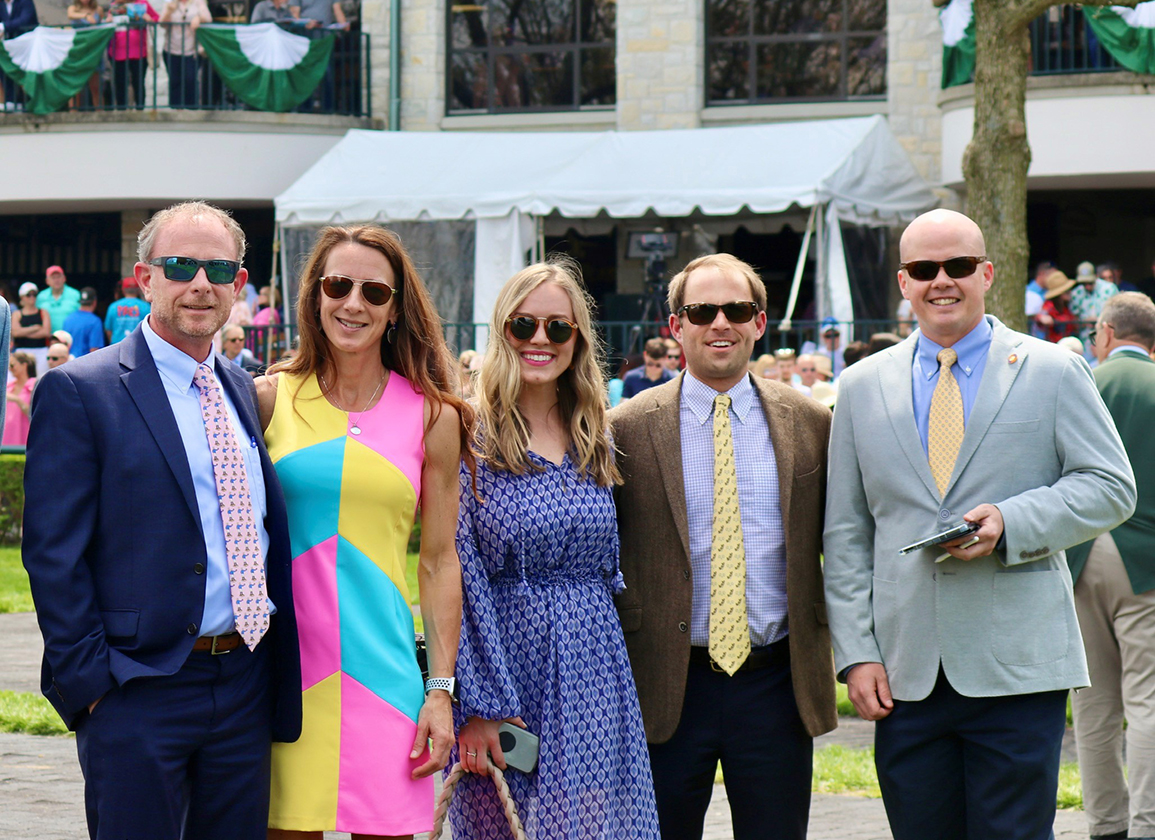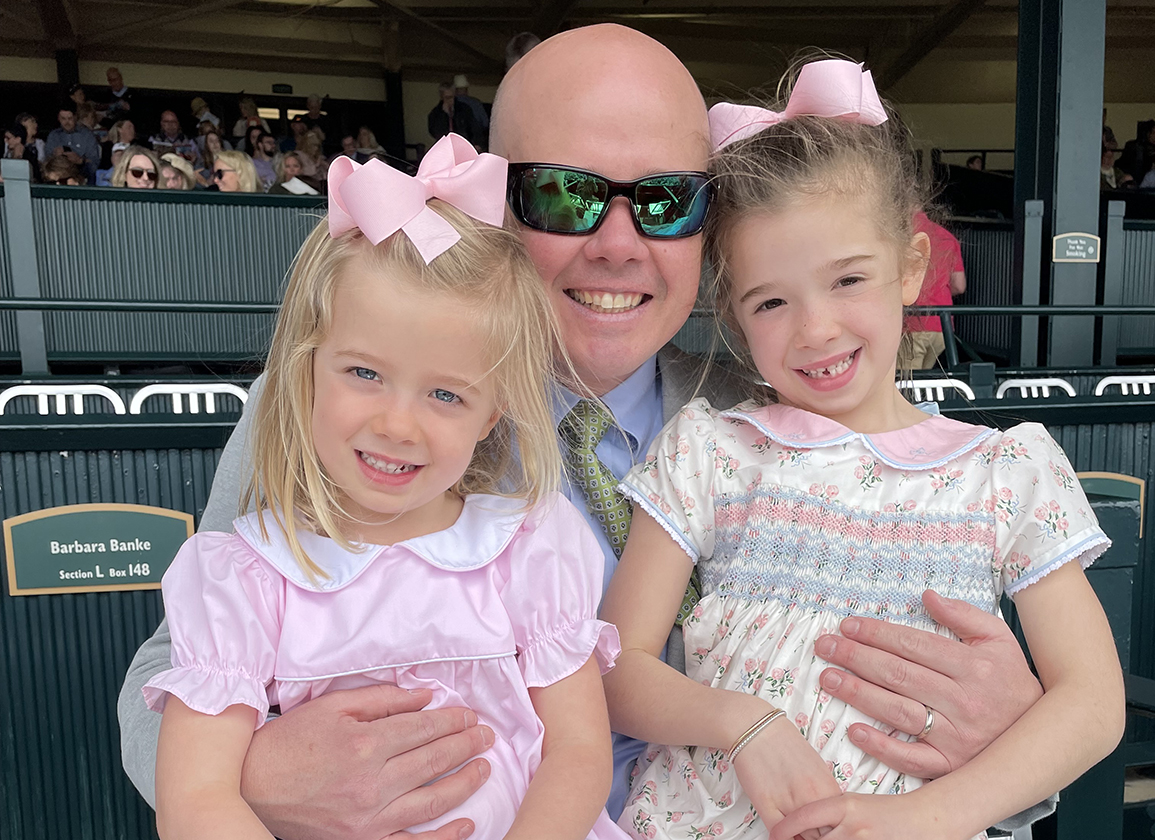Last month, James Keogh announced that Chance Timm would be joining him at his Grovendale Sales in a new partnership designed to expand their footprint in the sales consignment arena. Most industry people have dealt professionally with Timm at one time or another over his 15 years in the business, but while he has had some high-profile jobs, by and large, he has kept his head down and flown pretty much under the radar. He has preferred, as he says, to deflect the attention to the people he worked for and the success they had built.
As a principle at Grovendale, he now `is' the people he works for, and he sat down for a long-overdue talk to discuss the four horses they will offer at the Keeneland April Sale on Friday and provide some background about his life and history in the sport.
The Grovendale consignment features Hip 10, Suppressor (Munnings) a racing prospect; and three racing or broodmare prospects: Hip 82, First Sip (Ghostzapper), Hip 86, Lady Love Me (Star Guitar), and Hip 91, Winedown (Kantharos).
It's fairly certain that Timm himself will be the only Utah native consigning horses at the sale. He hails from the town of Murray, a suburb of Salt Lake City, and Utah's fourteenth-largest town. Timm's grandfather bred and raised Quarter Horses and trained racehorses, and his father and uncle rode races for their father. “My first experience in the horse world was those guys riding on the weekends in bush tracks,” he said. “There was no parimutuel wagering out there, so it was fairly limited. It was more a hobby than a real profession.”

Timm with clients Here We Go Stable | Alyssa Cumming photo
When his father died when Timm was just 11, he said he drifted away from the sport, before finding his way back a half-dozen years later.
“A big thing in the inter-mountain West in Utah, Idaho, Wyoming, is chariot racing,” he said. “They hook Quarter Horse racehorses to a chariot, kind of Ben-Hur style, and they race them for 440 yards in the wintertime. It's a big family event down there, and while it's dying now, it was really popular when I was in high school. And so my family always had chariot horses, too.”
Timm started helping out an uncle with his horses, driving them, getting them fit, and accompanying him to the races on weekends. “It was a great time for me, because I needed a really positive male influence in my life at that time, after my father had passed away, and he was it and the horses became a pathway to that.”
He started his college career at the University of Utah where he was offered a Reserve Officers' Training Corps (ROTC) scholarship, but decided to pursue horse racing at the University of Arizona on a Race for Education scholarship instead. But upon his graduation, he found that horse racing opportunities out West were few and far between. He worked as an assistant starter, galloped horses, and took a the job as the assistant racing secretary and clerk of scales at Arapahoe Park, which he described as “a miserable time.”
“I remember one day, late in the summer of the meet, they were racing Arabians and I was in the paddock watching them give a leg up on these Arabians, and I thought to myself, `I've got to get the heck out of here.'”
Two former U of A classmates had a suggestion that proved to be the answer when Jordyn Egan and Ian Tapp suggested he apply for the Darley (now Godolphin) Flying Start program. The experience was life-changing.
“It was huge for me,” he recalled. “I had never been out of the country when I applied to Flying Start. I didn't even have a passport.”
Timm is a soft-spoken, reflective person with a quick laugh who loves nothing more than a good intellectual debate. He is also someone who has put a lot of thought into what sort of job would make for a fulfilling life for him, his wife and two children.
Timm lives in Lexington, and is married to the former AbiGail Spalding, the daughter of Summer Wind farm manager Bobby Spalding, whom Timm credits with an important role in shaping his life and career. They have two young daughters.
“When I was on the course, I always thought I wanted to get involved in bloodstock,” said Timm. “When I was getting going, it wasn't uncommon at all for yearlings to bring $6, $7, $8 million. And funny enough, what I knew I didn't want to do was get into stallions, and I ended up loving it. When I was at WinStar doing seasons with Gerry Duffy and syndicating all those horses, that's when I really understood how it all worked, the syndication process and scouting the horses and trying to figure out what they're worth and what you can buy them for. And then I got to do even more of it at Lane's End. It's a great part of the industry, where you put a big bet on the line and then you go on and sell it. There's a lot of excitement behind it. It's great calling people up and saying, `Hey, we got the breeding rights to this horse and this is what we're going to stand him for, and we'd like you to partner with us.'”
In the end, what he learned was that he wanted to be in the relationships business.
“Luckily, during my time at Lane's End, I was pretty involved with the sales consignment. And apart from my responsibility to the stallion roster and all that came with that, they were gracious enough to let me be actively involved in recruiting and placement of horses in the sales consignment, and I really enjoyed that. One of the things I enjoy the most in this industry is meeting new people and talking to these people, finding out their story and where they're from, and then helping them along and watching their program succeed.”
At Grovendale, he'll get to build on that resume.
“I've come to realize that the sales process is something that I really, really enjoy, for all those same reasons. I like working closely with people and playing the long game and advising them on making sound decisions that pay off long-term, instead of taking shortcuts, or maybe just trying to get a nice horse for them, sell and move on. That's not really what I'm about or what James Keogh is about. We want to develop long-lasting relationships with people that trust us, and we have strong ties with them and watch their programs do well. I've come to realize how much I enjoy that part of it, placing horses in the sale, figuring out what's the best spot to sell them. Who's on the horse? How much is it going to bring? And going through that whole process.”

Timm at Keeneland with daughters Hallie and Vivian | courtesy Chance Timm
Grovendale will continue to feature its traditional services, including sales consignments, matings, investments and consultation. They will also continue to trade their own horses. Timm said having that kind of personal stake in the game is something that is critical to understanding your clients' business.
“James told me early on when I first got to know him that tuition in this game is not cheap, and the only way to learn it is to put your money up. And he's right. You learn all the time what works and what doesn't work. And I think if you've never lost money on a horse, it's hard to tell people-to look them in the face-and say that they are going to have to take a loss.”
Their expansion plans will focus on yearlings and horses of racing age.
“We'll be at all the major Kentucky sales,” he said. “We'll go to Saratoga with the right horse, but we'll stick mainly to Central Kentucky. The plan is to build the yearling and horses-of-racing-age areas of the consignment year-round. The breeding stock segment is always something that James has had a strong presence in, and obviously we'll continue to be involved there. But the primary focus is to further emphasize the quality of the breeding stock sales and build our presence in the yearling sales.”
The growing presence of digital and pop-up sales should further fuel business.
“Like most of the people in Central Kentucky, we trade horses. The market has become so concentrated at this point that there are very few of us that don't actively invest and trade horses. So for all of us that are advisors or industry professionals, digital sales provide a great opportunity to trade. But even beyond industry professionals, for participants that are looking to capitalize on something at the right time, it's an opportunity. And the reality is that this kind of stuff happens all the time. Horses trade privately at peak opportunities all the time. But the public marketplace gives buyers a lot of confidence, obviously. It gives people confidence and transparency. Boyd Browning has always said that the best place for sellers to maximize the value of a horse is at public auction, and he's right. There's no better way to value a horse than the open market.”
In the end, says Timm, he's just happy to work with someone for whom he has so much respect.
“There are very few people that have done more for me in the horse business than James Keogh,” he said. “I'm obviously biased and I've built this relationship with him over a long time, but James is one of the most generous people I've ever been around. He's a very kind, trustworthy person that gives his time and opportunities and just a hand to anybody and everybody that needs it–whether they're facing some kind of health ailment or they need help with fixing a fence or whatever it is.”
The important thing, he said, is that he and Keogh are on the same page when it comes to their goals for their clients.
“I think this is all based on relationships and building a relationship with somebody that you can trust and you have confidence in. That's really what I want to stand behind. I want the people that I work with and on whose behalf I work to have the trust and confidence that I'm looking out for their best interest. And that's always going to be the preemptive motivation for what we're trying to do.”

The post Timm, Grovendale Debut New Partnership at Keeneland appeared first on TDN | Thoroughbred Daily News | Horse Racing News, Results and Video | Thoroughbred Breeding and Auctions.
Source of original post


